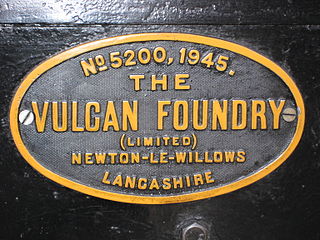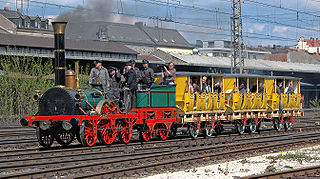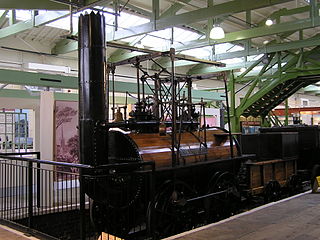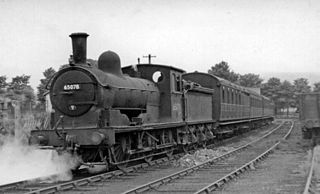
Stephenson's Rocket is an early steam locomotive of 0-2-2 wheel arrangement. It was built for and won the Rainhill Trials of the Liverpool and Manchester Railway (L&MR), held in October 1829 to show that improved locomotives would be more efficient than stationary steam engines.

The Vulcan Foundry Limited was an English locomotive builder sited at Newton-le-Willows, Lancashire.

The Bowes Railway, built by George Stephenson in 1826, is the world's only operational preserved standard gauge cable railway system. It was built to transport coal from pits in Durham to boats on the River Tyne. The site is a scheduled monument. The railway is open every week on Thursday, Friday and Saturday as well as on a number of event days throughout the year.

Under the Whyte notation for the classification of steam locomotives, 2-2-2 represents the wheel arrangement of two leading wheels on one axle, two powered driving wheels on one axle, and two trailing wheels on one axle. The wheel arrangement both provided more stability and enabled a larger firebox than the earlier 0-2-2 and 2-2-0 types. This wheel arrangement is sometimes described as a Single, although this name could be used to describe any kind of locomotive with a single pair of driving wheels.

Locomotion No. 1 is an early steam locomotive that was built in 1825 by the pioneering railway engineers George and Robert Stephenson at their manufacturing firm, Robert Stephenson and Company. It became the first steam locomotive to haul a passenger-carrying train on a public railway, the Stockton and Darlington Railway (S&DR).

The North Eastern Railway (NER) Class C1, was a class of 0-6-0 freight locomotives designed by T.W. Worsdell. They were used throughout the NER system, although particularly in Teesside between 1886 and 1962.

Alan Keef Ltd is a British narrow gauge railway engineering company which manufactures, overhauls, and deals in narrow gauge locomotives, rolling stock and associated equipment.

The Fairy Queen, also known as the East Indian Railway No. 22, is a steam locomotive which was built in 1855. It was restored by Loco Works Perambur, Chennai in 1997, and housed at the Rewari Railway Heritage Museum.
Robert Stephenson and Company was a locomotive manufacturing company founded in 1823 in Forth Street, Newcastle upon Tyne in England. It was the first company in the world created specifically to build railway engines.

The Baguley valve gear is a type of steam engine valve gear invented by Ernest E. Baguley, the Chief Draughtsman of the W.G. Bagnall company of locomotive manufacturers and patented in 1893. It was used by Bagnall during Baguley's time there, then by his own company of Baguley Cars Ltd.

The National Rail Museum in Chanakyapuri, New Delhi, displays exhibits on the history of rail transport in India. The museum was inaugurated on 1 February 1977. The museum spans over an area of over 11 acres and the indoor gallery comprises an octagonal building which houses six display galleries and a large open area is laid out to simulate the atmosphere of a railway yard. It is open every day except Mondays and national holidays.

The East Indian Railway Company, operating as the East Indian Railway, introduced railways to East India and North India, while the Companies such as the Great Indian Peninsula Railway, South Indian Railway, Bombay, Baroda and Central India Railway and the North-Western Railway operated in other parts of India. The company was established on 1 June 1845 in London by a deed of settlement with a capital of £4,000,000, largely raised in London.

Patiala State Monorail Trainways (PSMT) was a unique rail-guided, partially road-borne railway system running in Patiala from 1907 to 1927. PSMT was the second monorail system in India, after the Kundala Valley Railway, near Munnar in Kerala, and the only operational locomotive-hauled railway system built using the Ewing System in the world. The Kundala Valley Railway pre-dated this, also using the Ewing system between 1902 and 1908, although this only used bullocks for haulage. Following the conversion of the Kundala Valley Railway from a monorail to a narrow gauge railway in 1908, PSMT was the only monorail system in India until its closure in 1927. These were the only instances of a monorail train system in India, until the Mumbai Monorail was opened on 2 February 2014.

Steam Elephant was an early steam locomotive from North East England.

Rishra was built in 1921 by Baguley Cars Ltd. Following a working life in India it is now preserved at the Leighton Buzzard Light Railway, Buckinghamshire, England.

The Hetton Colliery Lyon or Lyons is an early British steam locomotive that still survives in preservation. It is remarkable for having continued working into the early 20th century.

Electric Loco Shed, Ghaziabad is a motive power depot performing locomotive maintenance and repair facility for electric locomotives of the Indian Railways, located at Ghaziabad Junction of the Northern Railway zone in Uttar Pradesh, India. It is one of the two electric locomotive sheds of the Northern Railway, the others being at Ludhiana (LDH).

Beamish Museum contains much of transport interest, and the size of its site makes good internal transportation for visitors and staff purposes a necessity.

Electric Loco Shed, Bhusawal is a motive power depot performing locomotive maintenance and repair facility for electric locomotives of the Indian Railways, located at Bhusawal of the Central Railway in Maharashtra, India. It is one of the three electric locomotive sheds of the Central Railway, the others being at Kalyan (KYN) and Ajni. As of 1 August 2020 there are 203 locomotives in the shed.



















